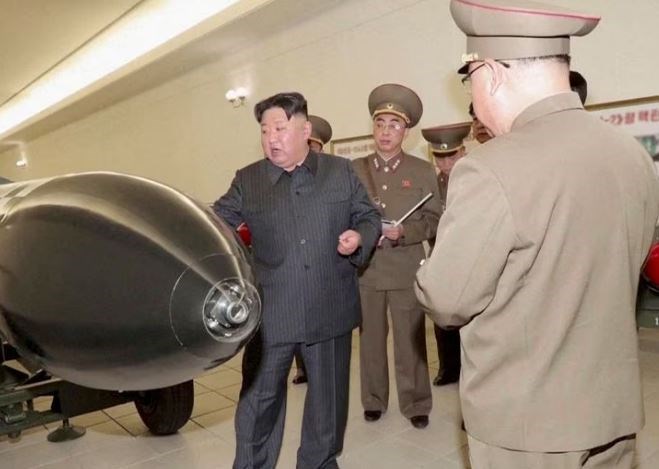DPRK's Kim vows more 'practical, offensive' war deterrence
The DPRK has been responding to recent joint military drills by South Korea, the US, and Japan -- which, according to KCNA, were designed to get Pyongyang to appraise "powerful practical action."
-

A screen grab shows DPRK leader Kim Jong Un inspecting nuclear warheads at an undisclosed location in this undated still image used in a video. (Reuters)
DPRK leader Kim Jong Un urged strengthening the country's war deterrence in a "more practical and offensive" manner to confront what he described as acts of aggression by the US and South Korea, state media KCNA reported Tuesday.
Kim made the remark at an enlarged gathering of the Central Military Commission held on Monday to tackle ongoing efforts to heighten the country's war deterrence to "cope with the escalating moves of the US imperialists and the South Korean puppet traitors to unleash a war of aggression," KCNA added.
The DPRK has been responding to recent joint military drills by South Korea, the US, and Japan-- which, according to KCNA, were designed to get Pyongyang to appraise "powerful practical action," including military options, in order to get ready for "an all-out war."
Kim requested further buttressing of the country's war deterrence with "increasing speed" and in a "more practical and offensive" approach, as per KCNA.
The gathering "discussed practical matters and measures for machinery to prepare various military action proposals that no means and ways of counteraction are available to the enemy," it added.
Meanwhile, senior defense officials from South Korea and the US were scheduled to meet in Washington on Monday and Tuesday for their annual Korea-US Integrated Defense Dialogue (KIDD), according to Seoul's Defense Ministry.
Discussion topics included methods to enhance the American nuclear umbrella's operation, as well as coordinated responses to the DPRK's nuclear and missile threats.
The trilateral defense discussions will then include Japan on Friday. The three nations voiced their alleged worry over DPRK's use of "malicious" cyber actions to finance its nuclear programs last week.
Hirokazu Matsuno, the senior cabinet secretary in Tokyo, claimed on Monday that Pyongyang could carry out other provocations, such as nuclear testing.
US-South Korea drills driving tensions to 'brink of nuclear war': DPRK
This comes as both US and South Korean forces conducted a series of annual springtime military drills in March, including their first large-scale amphibious landing drills in five years. The joint air and sea exercises, among others, involved a US aircraft carrier and B-1B and B-2 bombers.
The DPRK announced that the joint military drills by the United States and South Korea are creating tensions on the Korean Peninsula to the "brink of a nuclear war," vowing to respond with "offensive action".
It also warned that "the drills have turned the Korean Peninsula into a huge powder magazine which can be detonated any moment," adding that the international community is hoping for a nuclear war to loom over the Korean Peninsula.
A nuclear-capable B-52 bomber was deployed to the Korean Peninsula last Wednesday in a show of strength against Pyongyang on the pretext that it might conduct a nuclear test. The US long-range bombers were sent for the first time to the peninsula during the month.
Last month, Seoul and Washington both concluded their regular springtime exercises, called Freedom Shield 23, but are now conducting amphibious landing drills. During the same period, both the US and South Korean militaries conducted their biggest field exercises in five years, as well as computer simulations for command post-training.
The US also sent its nuclear-powered USS Nimitz aircraft carrier for naval training by the end of March with South Korea.
The US, South Korean, and Japanese navies began their first anti-submarine drills in six months on April 3 to allegedly strengthen their coordination against what they call an increasing missile threat from DPRK.
Developments rise as Washington and Seoul expand their combined military drills in response to what they call the DPRK's nuclear and missile threats. As a permanent military presence in South Korea, the US has 28,500 troops scattered around the country.
That said, DPRK leader Kim Jong Un has recently called on his military to get ready for war.
On April 3, South Korea and the United States held joint air drills involving at least one US nuclear-capable B-52H strategic bomber, as per Seoul's military.
The DPRK views such exercises as rehearsals for invasion and has responded to other recent drills with a spate of weapons tests.
In recent weeks, the DPRK launched an intercontinental ballistic missile and tested what the state-run media characterized as an underwater drone with nuclear capability. Meanwhile, the US and the South have ramped up defense cooperation.

 5 Min Read
5 Min Read








